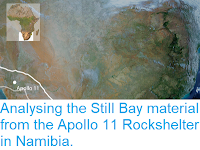A man has died after a flash flood hit a campsite in the Richtersveld Transfrontier Park on the border between Namibia and South Africa on Friday 8 February 2019. The flood hit the Namibia Wildlife Resorts' Hobas Lodge near the Fish River Canyon at about 9.00 pm local time, washing away a number of tents, and while it has been confirmed that all guests staying at the site were safe, the body of 22-year-old Ben Henry Markus, an employee of Namibia Wildlife Parks, was found the following morning.
Flood damage at the Hobas Lodge campsite in the Richtersveld Transfrontier Park, following a flash flood on 8 February 2019. Namibia Wildlife Parks.
Like
many desert areas southern Namibia, while generally arid, is
prone to occasional severe flooding. This stems from two causes; firstly
the arid climate prevents the development of a thick soil layer which
would be expected in less dry areas, so that in much of the area
(non-porous) bedrock is either exposed or close to the surface, and
secondly the hot climate leads to heavy evaporation from nearby South Atlantic
Ocean, so that if the wind changes direction and brings water-laden
air to the area, it brings a lot of precipitation with it. This
combination of heavy rainfall and low ground absorbency leads to large
amounts of water at the surface, typically moving downhill at some
speed. Dry channels or ravines through which these sudden floods
are channelled, can be particularly dangerous at these times,
particularly as they often appear to resemble natural pathways or even
camp sites to people unfamiliar with the climate.
The Fish River Canyon is the largest canyon in Africa, and the second largest in the world, after the Grand Canyon in Arizona, USA. The area is notorious for flood events, as the Fish River is seasonal in nature, flowing during the local rainy season, from November to March, then drying up for the remainder of the year. The Canyon is home to a popular trail at this time of year, with tourists typically taking four-to-five days to walk a navigable section starting at Hobas, and occasionally being caught out by unseasonal rain storms. However, this week's event was something different, with a particularly severe rainstorm during the rainy season causing flooding in an area usually above the reach of floodwaters.
The Fish River Canyon in Namibia. Thomas Schoch/Wikimedia Commons.
See also...
Follow Sciency Thoughts on Facebook.








